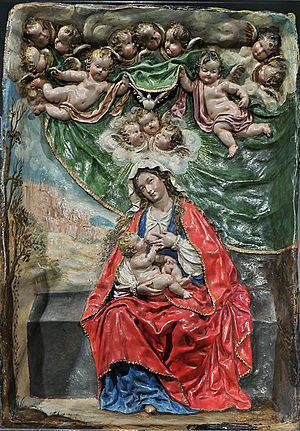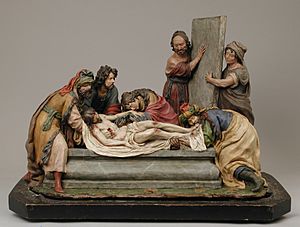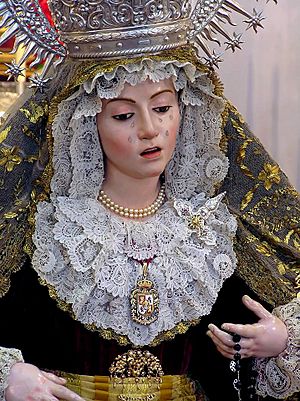Luisa Roldán facts for kids
Quick facts for kids
Luisa Roldán
|
|
|---|---|
| Born | 8 September 1652 |
| Died | 10 January 1706 (aged 53) |
| Resting place | Parish Church of San Andrés, Madrid |
| Nationality | Spanish |
| Education | Her father, Pedro Roldán |
| Known for | Sculpture |

Luisa Ignacia Roldán (born September 8, 1652 – died January 10, 1706) was a famous Spanish sculptor. People often called her La Roldana. She worked during the Baroque period, a time known for grand and dramatic art. Luisa was one of the first known female sculptors in Spain.
A famous writer, Antonio Palomino, said her work was as good as her father's. Her father, Pedro Roldán, was also a well-known sculptor. Luisa even became the official sculptor for King Charles II of Spain. This was a very important job.
Even with her royal title, Luisa had money problems. She died without much money, like many artists of her time. On the day she died, she was given a special award from the Accademia di San Luca in Rome. This showed how much her art was valued.
Contents
Early Life and Training
Luisa Roldán was born in Seville, Spain. Her father, Pedro Roldán, was a sculptor. Her mother was Teresa de Ortega. Luisa learned her craft from her father. She worked as an apprentice in his workshop. There, she learned to draw, shape clay, and carve wood. Her brothers and sisters also learned art from their father.
When Luisa was 19, she married Luis Antonio de los Arcos. This marriage was against her father's wishes. After getting married, Luisa moved to Cadiz. She opened her own workshop there from 1686 to 1688. Her husband and brother-in-law, Tomás de los Arcos, worked with her.
Luisa was the main sculptor. Her husband helped by painting the sculptures. He was skilled at painting realistic skin tones. They created many religious sculptures made of wood. These sculptures were often painted in bright colors.
Becoming a Royal Sculptor
Luisa made wooden sculptures for the Cádiz Cathedral and the city council. In 1688, she moved to Madrid. By 1692, she earned the title of "Sculptor to the Chamber." This meant she was the official sculptor for King Charles II. Later, she also worked for King Philip V.
She created a clay piece called Virgen con el Nino (Virgin with Child). She gave this piece to the Accademia di San Luca in Rome. She was accepted into this art academy near the end of her life.
Luisa had seven children, but only two lived to be adults. Her family faced hard times. They often did not have enough food because of money problems in Spain. Luisa tried to get help from Queen Maria Anna, King Charles II's wife. The queen sent some money, but it was not enough. Luisa's husband tried to get a job at the royal court to help, but he was not successful.
Her husband did help share her artwork with more people. King Charles II asked her to make a sculpture called Nazareno (Penitent). After the king died, this sculpture stayed in Luisa's workshop. Her husband tried to send it to Rome, but it was not liked by the person it was meant for. Luisa Roldán died in Madrid in 1706.
Famous Artworks
Luisa Roldán's sculptures have special features. They have clear outlines and thick hair. The clothes look like they are blowing in the wind. The faces are spiritual with gentle eyes, soft eyebrows, rosy cheeks, and slightly open lips.
Her sculpture of St. Ginés de la Jara, made around 1692, is now at the Getty Center in Los Angeles. She also made processional statues. These are statues carried in religious parades. Some of these include the Virgen de la Soledad (Virgin of Solitude) and Mary Magdalene. Her Virgen de la Soledad was very popular in churches.
In Cadiz, her works include statues of Anthony of Padua, Ecce Homo, and Saints Servandus and Cermanus. She made many religious sculptures for churches. These included statues of the Archangel Saint Michael and Mary Magdalene.
While living in Madrid, she also made small clay artworks. These were popular with everyday people. They used these small pieces for personal prayer. They showed religious scenes, people, and animals. Her art was found in many places. These included Andalusia, Madrid, and even New York and London.
Here are some of her important works still in churches:
- Most Holy Mary of Silence (María Santísima del Silencio), Jaén
- Carved wooden figures of San Servando and San Germán, patron saints of Cádiz, in the Cádiz Cathedral
- Saint Joseph, Iglesia de San Antonio, Cádiz
- Saint Anthony of Padua, Iglesia de Santa Cruz, Cádiz
- Saint John the Baptist, Iglesia de San Antonio de Padua, Cádiz
- Our Lady of Sorrows of the Remedies (Dolorosa de los Remedios), Jerez de la Frontera
- Virgin of Solitude (Virgen de la Soledad), Iglesia de la Victoria, Puerto Real
- Ecce Homo, Cádiz Cathedral. Made in 1684 from carved wood.
- Ecce Homo, Córdoba
- Archangel Saint Michael conquering a demon, El Escorial
- Christ of the Pardon, (Cristo del Perdón), Fregenal de la Sierra
- Saint Ferdinand, Cathedral of the Canaries, (Gran Canaria)
- Penitent (Nazareno), Iglesia de las Hermanas Nazarenas, Sisante

A statue of Mary Magdalene in Cádiz was destroyed by fire in 1936.
Other important works are in museums:
- Museum of Fine Arts of Seville
- Death or Ecstasy of Mary Magdalene, Marriage of Saint Catherine, Hispanic Society of America, New York City
- Saint Joachim, Saint Ann and the Virgin as a Child (La Virgen niña con San Joaquín y Santa Ana) and Jesus' First Steps (Los primeros pasos de Jesús), Museum of Fine Arts, Guadalajara, Spain
- Saint Michael, Royal Ontario Museum, Toronto, Canada.
- The Virgin Appears to Saint James Victoria and Albert Museum, London, England.
- The Entombment of Christ, Metropolitan Museum of Art, New York.
Artistic Style and Method
Luisa Roldán's art style came from her view of the world. It also came from the materials she could get. She used different types of wood for her detailed sculptures. She preferred two types that were soft and had a fine grain.
Luisa and her father, Pedro, made their sculptures strong but light. They used materials from different places. They had to pick materials carefully to make the statues stable. For example, they used Mediterranean cypress wood. They also used Spanish cedar for harder parts, like the hands.
Pedro used a technique called hollowing out wood sections. Luisa would work on smaller pieces, like the feet. Then she would carve the face. She made the face and beard in a special way. She carved a mask from a block of wood. This mask would then be joined to the back of the head. Finally, she added small details, like leaves, to the base. The finished sculpture was then given to a painter, Tomás de los Arcos.
Luisa Roldán's Legacy
Luisa Roldán had a big impact on other female artists. She influenced artists in Seville, Cadiz, and Madrid. In the 1600s, women artists often worked in private. Men's art was seen as more public. Luisa changed this by making her work public. She became known as a Spanish sculptor who made her own name.
Because of her art, she earned the royal title of "escultora de camara." She even wrote about her own life and art. Later, in the 1700s, more than ninety women artists were found to have been active in Spain and Portugal. This showed that many women were making art. Luisa Roldán is still known as one of the most important Spanish women artists. She helped create new art, especially with her clay figures and sculptures.
Images for kids
-
The Entombment of Christ (1701), Metropolitan Museum of Art
See also
 In Spanish: Luisa Roldán para niños
In Spanish: Luisa Roldán para niños




